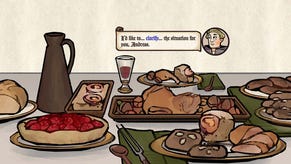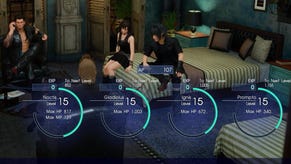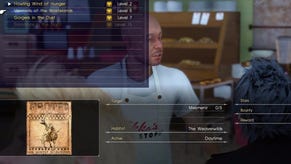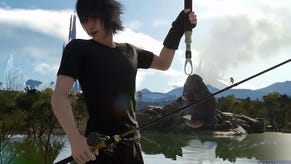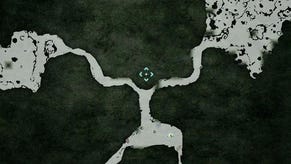Finishing Final Fantasy
Inside the team working to complete the most troubled Final Fantasy game ever made.
Editor's note: Hello! This piece originally ran in early November, but it seemed entirely appropriate to republish it this morning, now that a truly monumental piece of game development is finally reaching its conclusion. Enjoy!
Hajime Tabata was forced to own mistakes early into his career. A few weeks after the game designer joined Tecmo in the late 1980s, Yoshihito Kakihara, the company's eccentric founder, called his employees into his office. Kakihara was furious. The reviews of the studio's most recent Famicom game, Rygar, were in and they weren't good. The developers had neglected to include a save system, so reviewers had complained they'd had to leave their consoles on overnight in order to preserve their progress. Rygar had been in development while Tabata was still in college, yet he, along with every other Tecmo employee was ordered to visit the headquarters of each of the major Japanese video game retailers. On arrival, Kakihara explained, the staff must fall to their knees and issue an apology, followed by an assurance that their next game would be much, much better. It was, as Tabata puts it today, "harsh."
The indignity also provided preparation for his directorship of Final Fantasy 15, a multi-million pound production that, across its slurred decade of development, has been beset with problems, many of which Tabata inherited from his predecessor. In August this year Tabata, doing his best to mute his irrepressible grin, sat in front of a camera and recorded a message in which he apologised to fans and retailers for yet another delay for the game, which will now launch later this month. Delays like these may infuriate consumers, but they have more tangible consequences for that constellation of businesses that buttress the launch of a major game - the advertisers, the retailers and so on. For Tabata humility, rather than braggadocio, is the preferred posture in blockbuster video game development, where the stakes are often high enough to dash a business that missteps, and where team morale can, over the endless months of toil, be sapped and spoiled.

A month after he made his apology, I visit Tabata and his team, who together occupy an entire floor at the company's glass-encased office in Shinjuku. There's a marathon-closing atmosphere in the studio, whose staff seem weary yet emboldened by proximity to their goal. "When you've worked for so long on something like this, the thought of launching with something that's in any way unfinished is terrible," says Tomohiro Hasegawa, an art director who has worked on the game since the earliest days, when it was directed by Tetsuya Nomura. "While we've had to apologise unreservedly to retailers for messing up their plans, we've been so thankful for the extra weeks."
The office, cavernous, brightly lit, with endless phalanxes of desks arranged in orderly rows, is full of the sound of muted chatter. Here and there staff test the game at seemingly random points of the adventure. Lines of debug code flit in front of the images, providing a kind of programmer's narration of the action. Around them mock-up advertisements designed to deck out a subway train carriage line the walls. Next to them, a series of widescreen blackboards scrawled with encouraging messages from the series' fans in silver pen.
On one sideboard, there's a model reconstruction of the game's world map, complete with pins to show the locations of the major town and cities, and carefully painted miniature mountains, to show the topography. In a black frame hanging on the wall there's a many-legged centipede caught, according to the inscription, in Chiba in December 2012. In death the insect has provided inspiration for the clattering monsters that fill the game's countryside. Final Fantasy 15 is, like any video game that had demanded this much of its makers - the long nights, the spoiled relationships, the incoming RSI - a labour of back-ruining effort, and of heart-swelling love.
This much is surely true of many a major video game development - but it's rare for a studio to show its workings to an outsider, especially, in Japan, to a foreigner. Such openhearted access is almost unique in contemporary blockbuster game development. The typical studio visit to which journalists are invited is a heavily chaperoned affair, with a gaggle of public relations officers steering visitors through specific, possibly posed areas of the production, occasionally jumping in during a talking-point laden 15-minute interview with that conversation-rupturing refrain: "We're not ready to talk about that yet." Why the openness? "That's our philosophy," says Hasegawa. "We've had to be open and honest with each other, so it makes sense we'd do the same with others. If we want to speak to people around the world, how can you not be open, admit your flaws, try to point out your victories?"
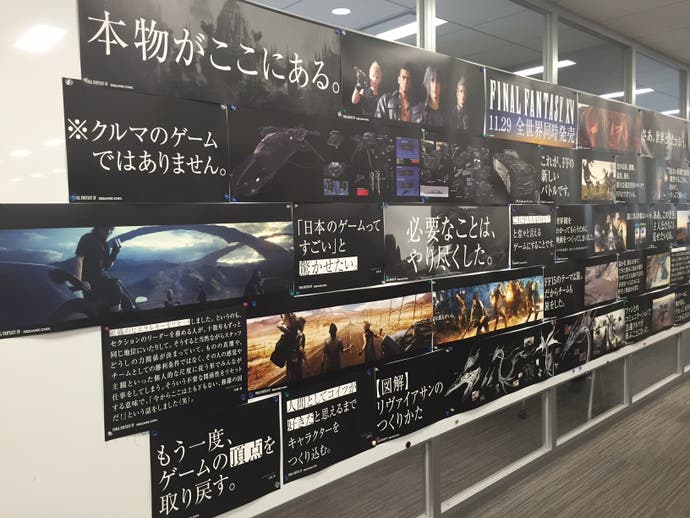
The team is not so open to tell us the story of what went wrong with Final Fantasy Versus 13, the game that morphed into Final Fantasy 15 in 2012, however. That may never be known (one Square employee tells me that Tabata and Hasegawa began telling him the story, over a drunken dinner, last year, and didn't stop talking for three hours) but there are obvious clues. In 2001 Final Fantasy The Spirits Within, a Hollywood film that borrowed the video game series' title and little else, lost approximately $94 million at the box office. In the aftermath, the film's director and Final Fantasy's originator, Hironobu Sakaguchi, was first side-lined, then shunted from the company. Senior staff, whom Sakaguchi had hired, soon followed.
Tetsuya Nomura, the artist who designed many of Square's best-known characters was promoted to the role of director on one of the company's next major titles, Final Fantasy Versus 13, to plug the gap. Despite his studied nonchalance in interviews, Nomura, now one of the company's most senior staff was reportedly an anxious director (during one event in Tokyo a few years ago, when early footage of the game was shown to fans, Nomura sat backstage in front of a monitor relaying live footage of the crowd's faces, so he could watch their reaction in real time.) The game lunged in different directions and, at some point, Nomura was removed from the project. Presumably to recoup sunk costs, the game was retooled and retitled as the next entry to the company's flagship series.
Tabata, who until this point had only worked on relatively minor projects, was promoted to director. He arrived to find an exhausted and fretful team. The new director's treatment was severe and controversial. "The entire staff was 'deconstructed' in a sense," explains Akira Iwata, a senior artist at Business Division 2. "Tabata created a flat environment; he got rid of the hierarchy. Everyone was put on the same level and had to make the argument for what they should be doing on the game. Some were freed up to do things that they'd longed to do but had previously been unable to take on. Others felt like they'd been demoted."

Such unplanned promotions and demotions are highly unorthodox inside a major Japanese company. It's a disregard for convention that Tabata learned early in his career at Tecmo. During his first ever job interview, Tecmo's founder Kakihara asked the young Tabata what unique quality he would be able to bring to the company. Rather than suggest a clichéd virtue (a willingness to learn, perhaps, or a talent for problem-solving) Tabata replied that he was good at giving massages. Kakihara ordered the young designer to come around to his side of the desk and give him a back rub on the spot to prove it. After a while Kakihara asked Tabata how his back felt. Tabata told him that it was tight and perhaps Kakihara was sick. Speaking physiological truth to power was a risky gambit. When Tabata left Tecmo that day he worried that he'd blown the interview. A few days later, a job offer arrived.
This openness and disregard for Japanese corporate convention proved essential in uniting the team that Tabata inherited. A few days after announcing the major team changes, the director booked a retreat in Tokyo for his new clutch of team leaders. There, the director told his staff that they weren't going to leave the room until they had come up with a list of golden rules by which they would all agree to abide. When the team finally emerged, they had settled upon a defining philosophy.
As we sit together while Tokyo's sweaty September rain falls outside, Iwata pulls a small piece of card from his wallet, like a well-thumbed photograph of a child. On it, printed in Japanese and English, are the six commandments that he and the other staff designed:
- Don't put the brakes on others' work.
- Recognise others' core values; welcome all ideas.
- Make goals clear, and share information with transparency.
- Speak openly and honestly with everyone.
- Go beyond the scope of your duties.
- Cherish your health and your loved ones' happiness.
These guiding principles were, according to Hasegawa, followed by a tangible shift in attitude across the team. "Suddenly we had this sense of being underdogs or challengers," he explains. "We were allowed to recognise that we had so much to understand in terms of the tech we were working with, in terms of the open world design, in terms of learning how to broaden the game's appeal beyond its niche." In this way, Tabata changed the atmosphere in the studio from one where everyone was afraid about what they might lose, to one where everyone was enlivened by the prospect of what they had to gain. "We became something closer to a task force," explains Kenichi Shida, an artist on the team. "You could be a task leader. Then a few days later you'd join another group as a worker. We're constantly changing desks. The rearrangement had an amazing effect on the team," I think. "By physically moving, it stops you from getting entrenched."
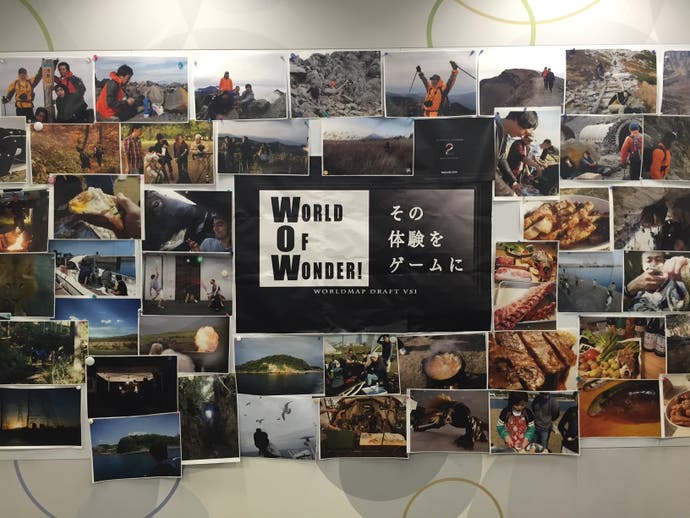
Tabata is not a faultless boss (one project manager, who sits close to Tabata's desk, mentioned that, if he comes into work in a bad mood, she's guaranteed to have a difficult day) but his unflinching belief in the power of togetherness clearly inspires those around him. "I place a lot of importance on people," he tells me. "That comes from the understanding that I can't manage this on my own. What I can do is to try to create an environment where those who have the necessary skills are able to shine. I love helping bring people's skills out to their fullest. I hope I'm the kind of leader who does that. I hope that, if you ask them, they see me in that way."
This attitude was also seeded in Tabata's early life, growing up in Sendai in Northern Japan. While Tabata enjoyed PC games like Civilization and Wasteland, he was a natural sportsman. He soon discovered that he was the fastest skier in his school. His talent took him to a regional tournament. There, however, his self-belief was pricked when he failed to win a medal. In the following weeks he watched the children who had beaten him at the regional finals lose to better competitors in the national competition. Finally, some of those national winners went on to the Olympics, where they in turn were beaten by competitors from other countries. "That stayed with me," Tabata told me. "There's always someone who is better than you. You can't ever be on top. Or, even if you do get there, there will always be someone who overtakes you eventually." If Tabata could not triumph as an individual, he decided that he could triumph by creating the best team of individuals. "I want to create a winning team," he says.
While much of the challenge Tabata has faced has been organisational, there's also the issue of what a Final Fantasy game should look like in 2016. The series reinvents itself with each new release, presenting a fresh world with fresh faces and systems, tied loosely to the franchise by way of a few unifying motifs. The reinvention helps stave off the kind of blockbuster fatigue that players of many annual western blockbusters report to feel, but presents an intimidating challenge to those designers tasked with defining each new game.
"The fight is with nostalgia as much as anything else," Tabata says. "Every player has their own memories and feelings toward different titles in the Final Fantasy series. At bare minimum, people have a graphical style they particularly like, or particular characters and universes. But deeper than that they want to feel the same feelings they had when they were kids, playing these games for the first time. They want to play a game that allows them to relive the excitement of the past, while also exceeding it in some way. But we decided early on that this game has to stand alone from all of the others; it can't just be a conglomerate of all the past titles."
Now, a few weeks away from launch, Tabata says that, even more than critics, family or peers, he will pay most attention to what players have to say about the game. But he's also keenly aware of what the series' past custodians will have to say. A few weeks after the launch of the Final Fantasy 15 demo in 2015, Sakaguchi contacted him to ask if they could meet for a drink. That night, Sakaguchi proceeded to point out all of the things he liked and disliked about the game. (In return, Sakaguchi told Tabata that he could ask him any question he wanted. "How much money do you have?," replied Tabata. "Anything but that," came the reply).
Tabata remains hopeful that he has struck the right balance of appealing to the old and to the new. "Yesterday Koichi Ishii, who worked on the original Final Fantasy, stopped by," he tells me. "It was humbling to hear him say that he was glad to see us creating a Final Fantasy that people are interested in, all these years later." It was a particularly affecting moment for Tabata as Ishii, who designed the series' line-dancing battle system, had previously criticised Final Fantasy XV's action-orientated feel. "He scolded me when that was first announced," says Tabata. "But yesterday he told me that it looked like everything was coming to life. He said that it looked like we'd found a way to make Final Fantasy into something new, while retaining something of its core essence. When he said that... I felt so happy."



